The other day, I was checking my CV…
It made me think about the early days of my career, specifically my time as an intern. In the Business School I’ve been to, we had a lot of internships to do (probably from 9 to 10, over a period of 5 – 6 years.
During one of these short term missions, I’ve been asked to send cold messages on LinkeIn… Yeah, now you picture it. It’s basically the same kind of messages you receive everyday to “hire you for that specific project” or “propose you the tool that’s gonna boost your sales by 10”. We receive this kind of (could we say it) SPAM, everyday.
I must confess, those initial attempts were far from thrilling. Imagine crafting messages so plain and direct that they could easily double as a cure for insomnia.
Yes, they hit the mark on being straightforward, but in a manner so devoid of flair that even a straight line would seem like a roller coaster in comparison.
I know what you’re thinking: “Is there a better way to do this?”
Absolutely, and it’s not just about adding a dash of excitement to your messages. Even if I’m far from being a professional about that, let’s share some ideas on paper!
How to get answers on LinkedIn?
Because that’s what we’re all dreaming about, isn’t it? Making sure the people you’re contacting will read and react to your message. They basically never heard about you but you want them to take action.
Instead of giving you a long check-list of different steps (that you would certainly find anywhere else online), I’d rather focus more on the state of mind you need to have, checking-up some of the cold messages I’ve received during the last weeks…
Crafting a Compelling Narrative
Imagine each message as a chapter in a story where you and the recipient embark on a journey together. The plot? Uncovering mutual interests and opportunities that benefit both of you. Instead of launching into a monologue about your needs and achievements, invite them into a dialogue. Share a piece of insight, a thoughtful observation about their work, or a relevant achievement of your own that ties into their interests. This approach turns the conversation into a two-way street, where both parties are engaged and valued:
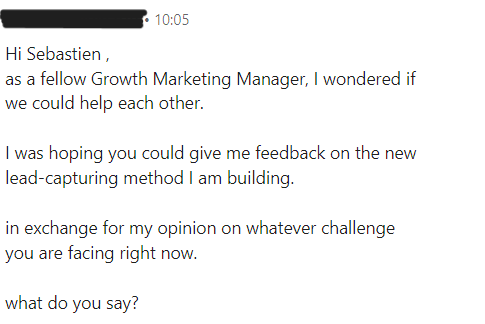
That’s a very interesting opening I got several weeks ago. The conversation slightly continued about the solution I was using, already knowing the feature of the tool I already read about.
As everybody get spammed with bland cold messages, this approach, targeted on my job and asking for a professional review (in exchange of professional advice) is a very good idea to me.
Listening and Adapting
True engagement on LinkedIn mirrors the dynamics of a lively conversation at a networking event. It requires active listening and adaptability. Pay close attention to cues in their profile, content they’ve shared, and the tone of their responses. These insights are invaluable, allowing you to tailor your messages and follow-ups in a way that resonates more deeply with their professional journey and current interests:
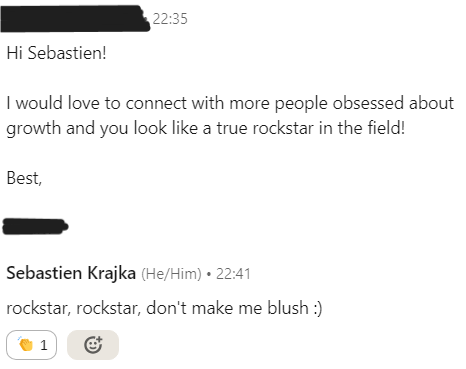
If 30% of U.S. adults report using LinkedIn, only 16.2% of them are Active Daily and we can guess (I didn’t find the stat), that a smaller portion of them are posting or sharing content every week, so you should be able to focus on profiles that would more likely see your message. I have a friend that created a profile once – probably 5 years ago and never came back. That guy won’t certainly react to your message.
Knowing When to Follow Up
Timing is everything. It’s about knowing when to take a step forward and when to pause, allowing space for the relationship to breathe and grow organically. A well-timed follow-up can show your genuine interest and commitment, but knowing when to step back is just as important. It reflects your respect for their time and boundaries, qualities that are often appreciated in the professional world:
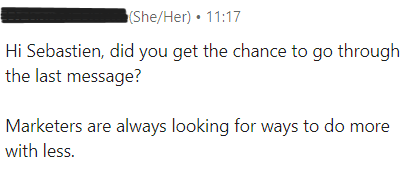
Be kind. Maybe the recipient didn’t just see your message. Everybody is busy. I don’t get all the notifications nor check my messages everyday. But sending a simple follow-up is not enough. In my opinion, you should add another incentive, like a link to a blog article or reacting to their most recent publications (with something really interesting or witty to say about it, not just complimenting them like a robot).
Being Yourself
Your authenticity is your greatest asset. Let your voice and personality shine through in your messages. Whether it’s a touch of humor, a dash of vulnerability, or your genuine curiosity, these elements make your messages memorable and relatable. Remember, people are more likely to engage with someone who feels real and approachable, rather than a perfectly scripted professional persona.
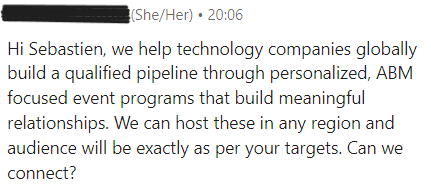
Let’s not be fooled about it. LinkedIn prospecting tools (like Waalaxy – a french solution I tested and that works pretty well) allowed us to automate our cold messaging operations. Thus, there is automation and automation. Just be yourself. You can craft a message that doesn’t sound like it’s sent to millions of other people at the same time.
Building Relationships, Not Just Connections
Let’s not lose sight of the ultimate goal: building meaningful relationships, not just amassing connections. This journey is about fostering trust, respect, and mutual support with professionals who share our interests and values.
By approaching each interaction with intentionality and a genuine desire to contribute, we lay the foundation for collaborations, mentorships, and friendships that enrich our professional lives.
I have no example for this… because I’ve never seen this before, but I’d like to get more relationships from LinkedIn. Whether you have something to sell me or not. I mean, LinkedIn is a social media platform. People could basically become more than a buyer or a seller.
I know I’m maybe asking too much.
But it could relate to some kind of B2B demand generation strategy: offering a relation (or a point of contact) to bring information to potential buyers without urging them to take action.
Maybe could it even become the next marketing trend? Who knows?
I won’t pretend to be a genius in the LinkedIn game. I’m not. I just tried to explain how SDR should contact me to get my attention… And I’m not different from others, I think.
Thank you for reading me this far!
Seb

Comments